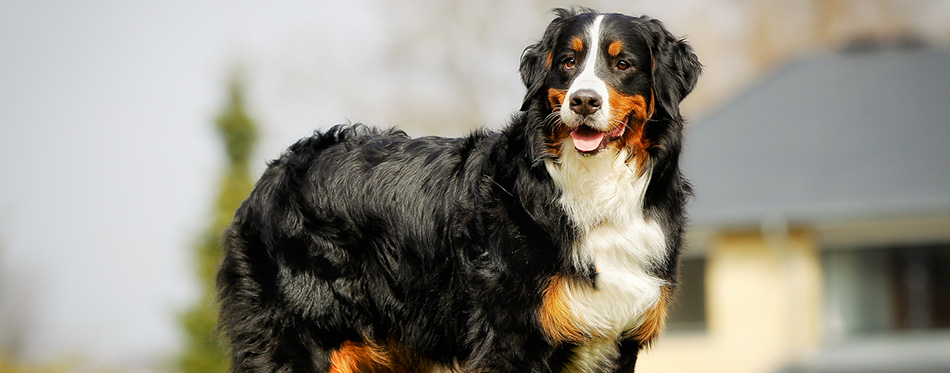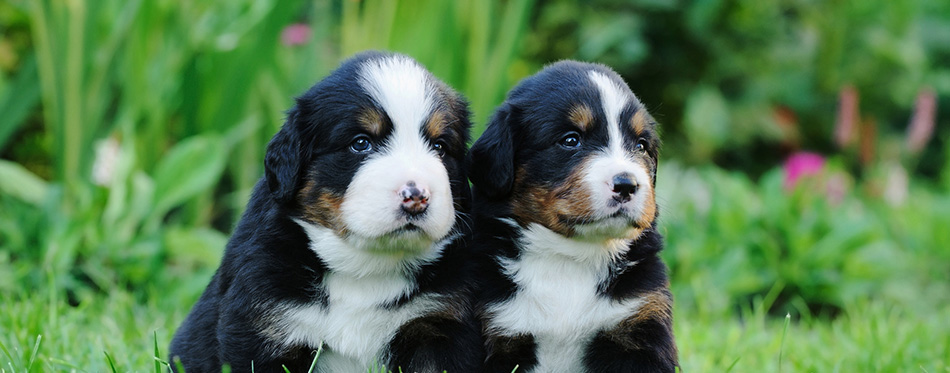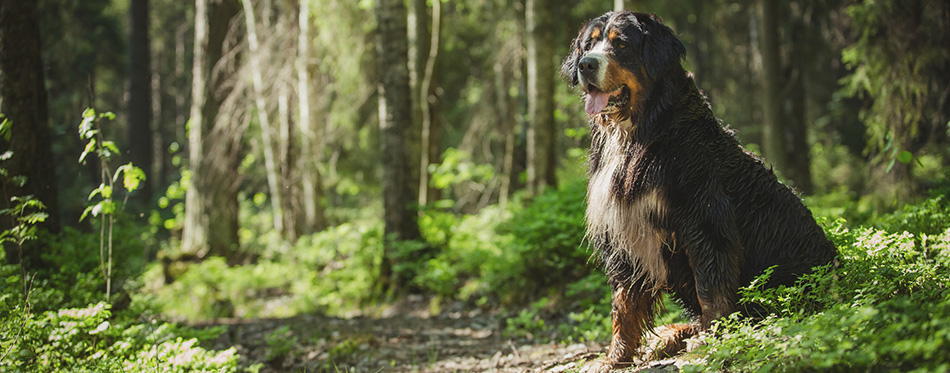The Bernese Mountain Dog is a remarkable canine breed that’s known for its reliable work ethic. It also has an affectionate and sweet nature that is perfect for peace-loving families. Berners are calm, placid, and good-natured. However, they will always find time to romp with their owner. Learn more about this adorable large breed of dog.

History of the Bernese Mountain Dog
The ancestors of the Bernese Mountain Dog are the Molossers that Roman soldiers brought with them some 2,000 years ago. These dogs served as guardians and protectors of the Roman supply lines and camps. Some of these dogs stayed in the area of the Swiss canton of Bern; hence, the name “Bernese”. This is one of Switzerland’s most important areas that produced cheese and chocolates.
The Bernese farmers mated these Molossers to local Swiss mountain dogs. The crossbreeding resulted in the creation of four distinct breeds of Sennenhunds or “alpine pasture dogs”. The Bernese Mountain Dog is second largest. All four have the characteristic tricolor coat pattern. However, only the Bernese Mountain Dog has a thick and long coat.
The Berner proved indispensable among dairy farms. They would pull their owners’ carts over the treacherous mountain passes of the Swiss Alps. They also served as guardians or protectors of their owners’ flock.
By the 19th century, the number of Bernese Mountain Dogs and the three other Swiss mountain dogs started declining. It was only through the efforts of Franz Schertenleib that the breed became popular again across Switzerland and the rest of Europe.
Schertenleib’s efforts led to the creation of a Swiss breed club in 1907, the Schweizerische Durrbach-Klub. Professor Albert Heim led the club as they strove to create the breed standards of the Berner. The club grew in membership after only 3 years. It would take three more decades before the AKC recognized the Berner as a distinct breed in 1937.
Today, the Bernese Mountain Dog is AKC’s 22nd most popular breed as of 2018. The dog also has a loyal following in German-speaking nations. Major kennel organizations recognize it as a breed. These include the FCI, ANKC, CKC, NZKC, KC, and the UKC.
Quick Facts About the Bernese Mountain Dog
The Berner has a colorful history. From farm dogs to guardians, Berners are now one of the favorite family companions. There are a few more facts you need to learn about this dog breed, however.
- A Large Dog
Never underestimate the size of a Berner. The puppies may seem cute and cuddly. However, they can grow into one of the largest and stockiest canine breeds on the planet. A male Berner can tip the scale at 165 pounds, with a lower limit of 100 pounds. Their female counterparts are lighter by about 10 pounds. While the Bernese Mountain Dog is a heavyweight, it is rather short. It can only grow up to 27.5 inches at the withers. Female Berners are also shorter by about 1.5 inches.
These are standards from the Federation Cynologique Internationale. The American Kennel Club, meanwhile, has a different size standard. Male Berners should be at least 80 pounds, with a 10-lb difference for females.
- Only Tricolor
Unlike other canine breeds that can come in different coat colors and patterns, the Bernese Mountain Dog should only have one – tricolor. Its main color should be jet black. The Berner’s cheeks, limbs, chest, and the area above the eyes should also have rich tan markings.
It should also have recognizable white markings. These include the symmetrical white markings on its head. There is a white blaze that extends from the head to the nose, forming a band around the muzzle. There can also be unbroken, moderately broad white marking on the dog’s chest and throat.
- A Reliable Worker
Berners are excellent workers. Their very first owners used the Berner as herding and guardian dogs. They also make excellent companions. By the 19th century, Berners began pulling carts filled with bread and dairy products. This is not surprising at all. The Bernese Mountain Dog is one of the strongest breeds of dogs. They can haul cargo that can weigh up to 1,000 pounds.
- The St. Bernard almost Made the Berner Go Extinct
The Bernese Mountain Dog shares many characteristics with other Alpine dogs, including the St. Bernard. In the late 19th century, people began favoring the hulking giant of the Swiss Alps over the other Swiss mountain dogs. The Swiss Kennel Club opted to showcase the St. Bernard instead of the other Swiss mountain dogs. By this time, only the people in remote areas had Berners and other mountain dogs.
- A Popular Breed among Celebrities and Important People
The AKC ranks the Bernese Mountain Dog as the 22nd most popular breed in the country in 2018. There are also famous personalities who own a Berner or who once owned such a breed. These include Sarah Michelle Gellar, Courtney Cox, Hillary Duff, and William H. Macy and his wife, Felicity Huffman, among others.

Things You Should Know
Living with a Bernese Mountain Dog can pose a number of challenges. It is a large breed that is quite prone to certain diseases. Its coat may also require extra TLC. One should also watch its diet, exercise, and training needs.
Health
Bernese Mountain Dogs share one very peculiar characteristic with other large and giant breeds. It has a shorter lifespan than small, medium, and toy canine breeds. On the average, a Berner can only reach up to 8 years. This is quite short, considering that there are dog breeds of the same size that can live up to 11 to 12 years. The oldest Berner reached the age of 15.2 years.
Cancer is the Berner’s number one enemy. Almost half of all the Berners in North America have cancer. What makes it more complicated is that there are many types of cancer that the Berner can suffer from. Berners are lovable family companions. Unfortunately, you have to prepare yourself to accept the fact that they may not live long enough for you to enjoy their company.
In addition to cancer, Berners are also prone to hip and elbow dysplasia, cruciate ligament rupture, osteochondritis, and arthritis. It is advisable to seek CERF and OFA certifications if ever you are going to get a Bernese Mountain Dog.
These dogs can also suffer from gastric dilatation volvulus, Panosteitis, Von Willebrand’s disease, portosystemic shunt, progressive retinal atrophy, and entropion. Gastric dilatation volvulus can have substantial implications on how you should feed the Bernese Mountain Dog.
Training
Bernese Mountain Dogs are intelligent. They are in the same ranking as the Belgian Malinois. This is not surprising since these canine workers are known for their obedience and eagerness to please their masters. When you combine these with their innate intelligence, you get a dog that is quite easy to train.
One should never wait until the Berner is an adult before you start training it. You can begin giving simple training lessons as early as 8 weeks of age. Housetraining and crate training are important for young Berners. You can also start with simple obedience commands. For a wider selection of choices, check out our dog crates guide.
Positive reinforcement works best for these dogs. They love to please their masters. Using treats and other rewards can help form stronger associations between the behavior and the pleasurable experience. Keep the sessions short, however. These dogs are not stubborn. However, their intelligence can make them feel bored a lot quicker if you keep repeating the same old thing.
Exercise
The Bernese Mountain Dog is a high-energy breed. It is a drafting and droving canine that has remarkable strength and speed. Unfortunately, it does not have the endurance of an Alaskan Malamute or a Siberian Husky. This Alpine breed is a sprinter, not a marathoner. It relies on its powerful legs to run after and drive cattle. They are also excellent cart-pullers. These activities should give you an idea of what kind of exercise you should give to your Berner.
They love going on a hike. Their favorite activity, however, is pulling toy wagons and small carts. Children love to ride in these carts and wagons that Berners pull. There is an annual holiday parade in Conway, New Hampshire, where Berner owners get to showcase the cart-pulling capabilities of their dogs. There are also Bernese Mountain Dog clubs that offer carting workshops. These dogs can also participate in carting competitions.
Berners love playing in the snow. They can dig holes and pull the sleigh of children. During the hot days of summer, one has to walk the Bernese only in the early morning or in the late afternoon. These dogs have a thick coat that is best suited for an Alpine environment and not in a tropical setting.
Nutrition
Bernese Mountain Dogs are slow to mature. They will not reach maturity until the third year of life. As such, one has to be very careful when feeding these dogs. You do not want them to grow sooner than normal. Doing so can lead to different health problems.
They need plenty of proteins in their diet. This will help maintain the health and function of their muscles. While puppies require more proteins than adult dogs, one should be careful against overdoing it. Giving too much protein can lead to faster growth. When you combine this with an increased calcium intake, the dog can have problems in its bones before it even reaches maturity.
It is for this reason that one should pay attention to the amount of dog food for the Bernese relative to its age, activity level, health status, and life stage. It is also crucial to feed the Berner at least twice a day to help reduce the risk of gastric dilatation volvulus.
Grooming
Berners are heavy shedders. They shed their coat all year round. However, they tend to shed the greatest during spring and fall. One should brush the Berner’s coat every day during these times of the year. In the summer and winter, brushing the coat once every week should be enough to maintain the health of both the skin and the dog’s coat.
These dogs also require regular baths. It can be as frequent as once every 2 months or as infrequent as twice a year. It depends on their activity levels and how often the dog spends its time playing in the dirt.
Pay special attention to the dog’s ears. The floppy nature of the Berner’s ears tends to trap dirt, liquid, and bacteria. Weekly assessment and cleaning are important. Do not neglect its teeth. Once a week brushing is better than not brushing the Berner’s teeth at all. Clip the nails, too, at least once every 3 to 4 weeks.
You may also like our articles on the Best Dog Toothpaste and Best Dog Toothbrushes.

Temperament
Bernese Mountain Dogs have a self-assured and good-natured temperament. They are calm in the presence of strangers, often bordering on being aloof. Only when they perceive their owners to be in danger do Berners show their guarding and protective instincts. Socialization is important in developing a well-mannered Berner.
These dogs are docile in the house. However, they enjoy the outdoors quite a lot. They love playing with their owners and their children. As a matter of fact, the Bernese Mountain Dog is one of Mother Nature’s most devoted nannies. It is like the English Bulldog that would not mind young children pulling on its coat or playing with its ears. It loves the attention it gets from children, regardless of how rambunctious they can be. Of course, one should still supervise dog-children interaction. The size of the Berner is something you cannot take very lightly, especially in the presence of small and very young kids.
Berners have great energy. However, they are also happy spending calm evenings with their family. It is as if the dog has an invisible switch that turns off its high-energy mode the moment it enters the house. This makes the Berner such an adorable companion for families as long as you can tend to its exercise needs every day.
The Bernese Mountain Dog is a great family companion as it is affectionate, calm, and good-natured. As long as you can tend to its health, nutritional, exercise, grooming, and socialization needs, the Berner can be a wonderful pet to have in the home.
Sources:
- Bernese Mountain Dogs – BMDINFO

